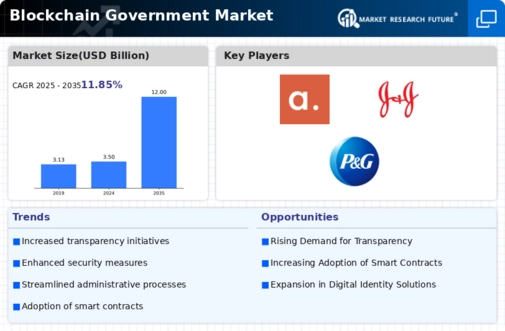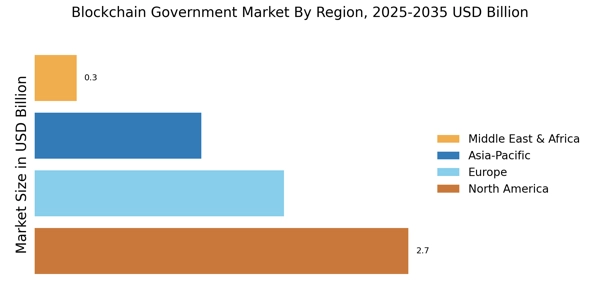The Blockchain Government Market is currently characterized by a dynamic competitive landscape, driven by the increasing demand for transparency, efficiency, and security in public sector operations. Key players such as IBM (US), Microsoft (US), and Accenture (IE) are at the forefront, leveraging their technological prowess to innovate and expand their offerings. IBM (US) has positioned itself as a leader in blockchain solutions for government, focusing on enhancing data integrity and streamlining processes. Meanwhile, Microsoft (US) emphasizes its Azure Blockchain Service, which facilitates the development of decentralized applications for government use. Accenture (IE) adopts a multifaceted approach, integrating blockchain with other emerging technologies to provide comprehensive solutions tailored to governmental needs. Collectively, these strategies foster a competitive environment that prioritizes technological advancement and collaborative partnerships.
In terms of business tactics, companies are increasingly localizing their operations to better serve regional markets, optimizing supply chains to enhance efficiency. The market appears moderately fragmented, with a mix of established players and emerging startups vying for market share. The influence of key players is substantial, as they not only set industry standards but also drive innovation through strategic collaborations and investments.
In August 2025, IBM (US) announced a partnership with the U.S. Department of Homeland Security to develop a blockchain-based identity verification system. This initiative aims to enhance security and streamline processes for government agencies, indicating IBM's commitment to leveraging blockchain for public sector applications. The strategic importance of this partnership lies in its potential to set a precedent for future government collaborations, showcasing the viability of blockchain in enhancing public trust and operational efficiency.
In September 2025, Microsoft (US) launched a new initiative aimed at integrating artificial intelligence with its blockchain solutions for government clients. This move is significant as it reflects a growing trend towards the convergence of AI and blockchain technologies, which could lead to more intelligent and responsive government services. By enhancing its offerings, Microsoft positions itself as a forward-thinking leader in the market, likely attracting more government contracts.
In July 2025, Accenture (IE) expanded its blockchain capabilities through the acquisition of a startup specializing in digital identity solutions. This acquisition is pivotal as it not only broadens Accenture's service portfolio but also strengthens its position in the government sector, where identity management is increasingly critical. The strategic move underscores the importance of innovation and adaptability in a rapidly evolving market.
As of October 2025, current competitive trends in the Blockchain Government Market are heavily influenced by digitalization, sustainability, and the integration of AI technologies. Strategic alliances are becoming more prevalent, as companies recognize the need for collaboration to enhance their offerings and address complex governmental challenges. Looking ahead, competitive differentiation is likely to evolve, shifting from traditional price-based competition to a focus on innovation, technological advancement, and supply chain reliability. This transition suggests that companies that prioritize these elements will be better positioned to thrive in the increasingly competitive landscape.


















Leave a Comment